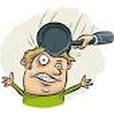
My good friend Grace Dodds was telling me this morning about her experience teaching in a one room schoolhouse in rural Alberta back around 1944.
It was a very cold winter, too cold in fact, for the children to go outside to play at recess. Grace was shocked at the mayhem that ensued when the first recess period began and the kids, aged 6-14, began tearing around. The younger children were trying to avoid being bonked on the head with books, wielded as weapons by the older, bigger children. Grace quickly pounded on her desk bell, got the children’s attention and told them that blows to the head could cause serious injury. She said that the first person to do this again would face the strap.
How did Grace know about the dangers of head injury in an era when it was considered hilariously funny when films showed one character breaking a vase over another person’s head? Grace knew because she herself suffered countless serious blows to her head as a child.
Grace’s mother would think nothing of violently whacking her on the head for no apparent reason. At one point an assault by her mother led to Grace’s nose bleeding non-stop for hours. And at school one day, a boy repeatedly hit her over the head with his metal lunch pail. Grace tells me that she well remembers at about the age of nine, knowing that she wasn’t as mentally sharp as she once was. She continued to receive top marks in school and is today a highly intelligent and alert 86 year old; nevertheless, she knows that a blow to the head can permanently affect the brain. Grace is writing her memoirs and I believe she has a lot to offer through sharing her experiences and hard-won wisdom.
More on brain injury: check out the article on Donald Parker in Better Brain Better Life: Tips and Tales from the Tantalizing World of Brain Science. Parker re-activated damaged neurons in a most unusual fashion.
